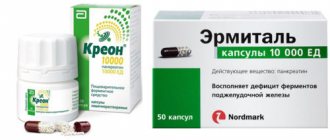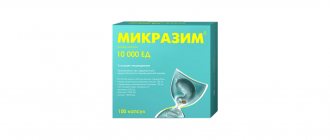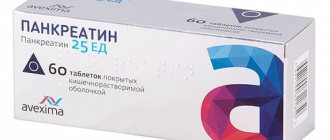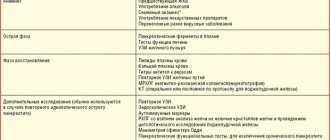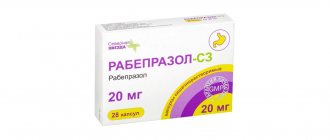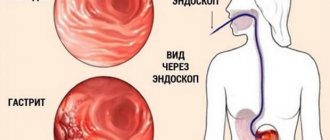Description, components and functions of the drug
Pancreatin promotes the production of the pancreas' own enzyme.
The drug Festal is a combination drug. It contains various digestive enzymes, namely pancreatin, dried ox bile, hemicellulase, lipases, amylases, proteases. Each of the components performs its own function:
- Pancreatin is an enzyme obtained from the pancreas of animals that breaks down proteins and fats and promotes the production of the pancreas' own enzyme.
- Ox bile - an extract secreted from the bile of cattle, speeds up the process of digestion of food, reduces the load on its own pancreas.
- Hemicellulase is an enzyme that actively dissolves and breaks down fiber in the body.
- Lipase is a substance produced by the pancreas, designed to digest fats.
- Amylase is a digestive enzyme that breaks down starch in the body.
- Protease – enzymes for protein digestion.
In addition to all of the above, the drug contains excipients such as gelatin, glucose, sucrose, talc, castor oil, etc. Before use, you must carefully read the instructions. The drug affects the absorption of other medications.
Everyone knows what Festal helps with. It eliminates the feeling of heaviness in the stomach and helps to digest food faster in case of problems with the pancreas, relieves nausea, eliminates bloating and excessive gas production, eliminates shortness of breath, and normalizes intestinal function.
The main function of the drug is to improve digestion and absorption of nutrients and vitamins in the small intestine. Festal not only serves as an enzyme substitute for pancreatic insufficiency, but also provokes the production of its own enzymes, activating the functioning of the gastrointestinal tract.
Festal is available only in the form of tablets or lozenges for swallowing. They are covered with a special shell that does not allow enzymes to activate ahead of time.
The incidence of chronic pancreatitis (CP) in Europe and Russia has increased 2–4 times over the past 10 years [1, 2]. Today, the frequency of detection of new cases of CP in the world is 4–25 per 100 thousand people per year [2]. In Russia, the prevalence of CP in adults is 27.4–50.0 cases per 100 thousand.
The most common causes of pancreatitis remain alcohol consumption (about 30%), cholelithiasis (GSD) and other diseases of the biliary tract (30–75%) in combination with overeating (Fig. 1). In 4–9% of cases, the main etiological factor of pancreatitis is chronic or acute ischemia in the abdominal aorta, which develops as a result of atherothrombosis or atherosclerotic stenosis of the celiac trunk. Over the past decades, the etiological role of atherosclerosis (dyslipidemia) as a predictor of the development of cholelithiasis in the genesis of cholegenic pancreatitis has been steadily increasing. Pancreatitis can also be caused by poisoning, trauma, viral diseases, surgery, endoscopic procedures, and side effects of medications. A common cause of pancreatitis is stressful psychogenic effects and chronic nervous overstrain, which cause a spastic state of blood vessels, as well as muscles at the exit of the bile and pancreatic ducts.
Use of pancreatin preparations
Modern treatment of a patient with CP almost inevitably leads to the need to prescribe pancreatin preparations on average 10–15 years from the onset of the disease - at the stage of fibrosis and/or calcification of more than 50% of the pancreatic parenchyma (PG) and simultaneous reduction of the severity of pancreatogenic pain. Progressive calcification of the pancreatic parenchyma occurs in CP of any etiology, although it is known that chronic alcohol intoxication accelerates this process [3, 4]. Destruction or atrophy of the exocrine part leads to a progressive decrease in the secretion of bicarbonates and enzymes secreted by the pancreas (Table 1).
However, it is believed that due to a deficiency of external secretion, primarily a deficiency of pancreatic lipase, clinically significant digestive disorders with the development of malabsorption syndrome develop when about 90% of the pancreatic parenchyma is replaced [2]. This is because the secretion of pancreatic lipase in a healthy adult is 1000 times greater than the amount of enzyme required for daily fat utilization in an average diet.
According to international consensus, the basic principles of treatment of CP with exocrine insufficiency are:
- Elimination of the etiological factor.
- Relief of abdominal pain.
- Diet therapy with frequent and split meals when the diet contains:
- animal fat
- triglycerides with an average chain length of 80–120 g/day;
- protein 80–120 g/day;
- unrefined carbohydrates 300–400 g/day.
- Pancreatin replacement therapy for pancreatic insufficiency (therapy with microgranulated pancreatin preparations containing lipase more than 10 thousand IU).
- Elimination of hyperacidity in the duodenum.
- Prescription of fat-soluble vitamins (A, D, E, K).
- Control of carbohydrate metabolism, compensation for diabetes [4].
- standard definition of structural disorders in the pancreas, according to the Cambridge classification;
- detection of a decrease in the content of elastase or trypsin in feces or blood plasma using one of the highly informative laboratory research methods.
Compensation for exocrine pancreatic insufficiency is based on the use of high doses of microgranulated pancreatin enclosed in a gelatin capsule as part of combination pharmacotherapy for CP [5, 6]. The prescription of pancreatin for the treatment of pancreatogenic pain remains controversial today, 150 years after its introduction into clinical practice. At the same time, many experts believe that classical tablet preparations of pancreatin in an enteric coating are more effective for the painful form of pancreatitis than capsules, in which each of the microparticles of pancreatin is enclosed in an enteric coating [7]. It has only been proven that the drug for replacement therapy must be protected by an acid-resistant coating, since the risk of enzyme destruction in the acidic environment of the stomach (inactivation of up to 80% of lipase activity) cannot be assessed a priori. Pancreatin preparations must have an optimal ratio of lipase and proteases, since with an excessively high content of proteases, lipase inactivation is significantly accelerated.
Prescribing combined preparations of digestive enzymes containing bile to patients with CP is no less controversial [6, 7]. Obviously, these drugs should not be used during exacerbation or painful form of CP, since bile acids increase pancreatic secretion, have a cholekinetic effect and stimulate intestinal motility. However, the known antispasmodic effect of bile acids, when prescribed to patients with severe dyspepsia and without persistent complaints of abdominal pain, combined preparations of digestive enzymes containing bile, can not only correct digestive disorders [8], but also become a method of etiopathogenetic therapy of cholelithiasis and chronic cholegenic pancreatitis (Table .2).
The total dose of pancreatin for CP with exocrine insufficiency can reach 200 thousand IU of lipase per day. Obviously, lifelong use of such high doses of pancreatin creates a high iatrogenic and economic burden, so the diagnosis of exocrine insufficiency must be verified.
The basis for verification of this diagnosis is the following criteria:
Meanwhile, the use of various digestive enzyme preparations in outpatient and clinical practice far exceeds both the prevalence of verified exocrine insufficiency and the total number of cases of CP. Everywhere, preparations of microgranulated and simple pancreatin with a high content of lipase are prescribed by doctors of all specialties for the correction of complaints, which in practice are traditionally considered (along with a diffuse increase in the echo density of the pancreatic parenchyma during ultrasound examination) as symptoms of CP with exocrine insufficiency, for example:
- feeling of fullness;
- nausea;
- rumbling, transfusion;
- flatulence;
- periodic abdominal pain;
- various stool disorders: constipation, diarrhea, increased volume and color change, admixtures of semi-digested food in the stool.
In other words, the clinical manifestations of exocrine pancreatic insufficiency often include “surrogate” nonspecific symptoms of intestinal dyspepsia (maldigestion), which may equally likely reflect dysfunction of the stomach, duodenum, pancreas or biliary tract. According to our data, in Russian megacities, up to 90% of elderly patients routinely hospitalized in the gastroenterology department, and up to 50% of elderly patients hospitalized in the therapy department of a territorial multidisciplinary hospital, receive one or another digestive enzyme preparations during inpatient treatment, regardless of diagnosis of the underlying disease.
In fairness, it should be noted that when choosing an effective drug, this “non-targeted” and usually low-dose prescription of pancreatin does indeed successfully relieve the symptoms of maldigestion. And this happens because in most cases, patients do not have exocrine pancreatic insufficiency, and digestive disorders are caused by inadequate hydrolysis of dietary fats in the initial parts of the small intestine, primarily in the duodenum. Pancreatic lipase can catalyze the hydrolysis of insoluble lipids only after emulsification of dietary fat under the influence of bile acids that make up bile and the formation of a stable emulsion of small fat droplets - micelles - in the lumen of the small intestine. The formation of micelles increases the solubility of fatty acids and monoglycerides in water by 100–1000 times.
Thus, the most important reasons for this relative “deficiency” of pancreatic exocrine secretion are:
- overeating (inconsistency of pancreatic secretion with an individual diet high in fat);
- inactivation of pancreatin due to hyperacidity and a shift in pH in the lumen of the duodenum to the acidic side, for example, acidic gastric dyspepsia due to chronic ischemia of the gastric mucosa with atherosclerosis of the celiac trunk, impaired systolic function of the heart or the development of NSAID gastropathy;
- lack of activation of pancreatic juice lipase against the background of cholelithiasis, severe disturbances in the motility of the biliary tract and duodenum, leading to insufficient secretion of bile acids and emulsification of dietary fats (Table 3).
Cholegenic chronic pancreatitis
It has been established that the proportion of cholelithiasis in the genesis of CP is population-based and varies around the world within the range of 23–92%: in Europe, cholelithiasis causes about 25% of cases of CP, while in the USA its cholangiogenic nature has been proven in two thirds of cases [ 2, 9]. In Russia, CP is detected in 25% of patients undergoing surgery for cholecystitis; moreover, removal of the gallbladder for calculous cholecystitis does not lead to the disappearance of pancreatic disease [9]. The main mechanism for the development of pancreatitis in cholelithiasis is more or less pronounced obstruction of the pancreatic ducts in the absence of clinically significant primary fibrosis or calcification of the parenchyma.
A characteristic feature of CP in cholelithiasis is the relative demographic and constitutional homogeneity of patients: the absence of a connection between the disease and chronic alcohol abuse and the presence of common predictors of impaired cholesterol metabolism, the development of cholelithiasis and atherosclerosis [8], such as:
- increased activity of HMG-CoA (3-hydroxy-3-methylglutaryl-coenzyme A) reductase in the liver;
- decreased activity of 7a-hydroxylase in the liver;
- increased lipolysis in peripheral tissue;
- increased absorption of cholesterol in the intestine (Fig. 2, Table 4).
Predictors of the development of cholelithiasis common to atherosclerosis and cholelithiasis simultaneously lead to dyslipidemia, the formation of cholesterol stones and high bile viscosity with the subsequent development of CP and insufficient activation of lipase due to insufficient secretion of bile acids, desynchronization of the secretion of bile and pancreatic juice. From a clinical point of view, this leads to digestive disorders in the phase of postprandial secretion and the prevalence of maldigestion, occurring without abdominal pain, with preserved secretion of pancreatic lipase even in patients with long-term verified cholelithiasis.
Thus, the main role in the development of cholegenic pancreatitis is played by:
- motor dysfunction of the biliary tract;
- increased lithogenicity of bile due to its oversaturation with cholesterol;
- formation of cholesterol stones [10].
In elderly patients, a number of factors can aggravate the course of cholegenic pancreatitis and concomitant dyspepsia. The most important factors include the development of the following, closely associated with old age, functional disorders of the biliary tract:
- decreased contractility and increased volume of the gallbladder on an empty stomach (in older men);
- non-gender related increase in the tone of the sphincter of Oddi and dilation of the common bile duct;
- decreased tone of the sphincter of Oddi in the presence of a juxtapapillary diverticulum, which is accompanied by a high incidence of duodenobiliary reflux, ascending cholangitis and choledocholithiasis [8].
An equally significant aggravating factor is polymorbidity and the influence of heart and vascular diseases on the course of cholegenic pancreatitis. The development of chronic ischemia of the mucous membrane of the upper gastrointestinal tract (GIT) and pancreas in patients with atherosclerosis of the abdominal aorta, heart failure, or receiving polyvalent pharmacotherapy (digoxin + diuretics + NSAIDs) leads to a variety of disorders of gastric and pancreatic secretion, as well as impaired gastrointestinal motility and bile ducts. Against this background, some elderly patients undoubtedly develop true atrophy or “age-related involution” of the pancreas with disruption of the endocrine and external secretion of the pancreas. Thus, among the many components of the dyspepsia syndrome in cholegenic CP, it is the “discoordination” of the motor activity of the gastrointestinal tract and the activity of the digestive glands that leads to the appearance of persistent digestive disorders, requiring permanent pharmacotherapy and adherence to a diet low in fats and extractive substances, which ultimately sharply reduces the quality of life patients [9]. However, the prevalence of symptoms of dyspepsia, as well as the absence of severe disorders of the exocrine pancreas in the majority of patients with pancreatitis against the background of cholelithiasis, are a solid theoretical basis for the use of bile-containing combined preparations of digestive enzymes with a low content of lipase, which can not only correct these complex digestive disorders, but also become a method etiopathogenetic therapy of cholelithiasis and chronic cholegenic pancreatitis.
Own research
The purpose of the study presented below was to evaluate the effectiveness and safety of treatment of digestive disorders in patients with CP and cholelithiasis with various preparations of digestive enzymes containing simple pancreatin, one of which was the combined drug Festal containing cattle bile (pancreatin - 192 mg, lipase - 6000 IU, amylase – 4500 IU, protease 300 IU, hemicellulase – 50 mg, ox bile extract – 25 mg).
Material and methods
The study included 120 patients (82 women and 38 men) with chronic pancreatitis due to cholelithiasis. The average age of the patients was 60.1 ± 9.0 years, the duration of the history of cholelithiasis was 6.2 ± 13.0 years. The study was organized as a simple randomized study with a comparative assessment of the effectiveness and safety of the use of such combined pancreatin preparations as Festal, Penzital (6000 IU lipase) and Mezim forte (3500 IU lipase) in relation to the correction of symptoms of maldigestion in patients with CP and cholelithiasis. Depending on the prescribed enzyme preparation, patients were divided into groups comparable in clinical and demographic data. Randomization of the main and control groups was carried out using the random number method.
Criteria for inclusion of patients in the study:
- age 18–75 years;
- indigestion syndrome;
- state without exacerbation of CP;
- condition beyond exacerbation of chronic cholecystitis;
- the patient’s consent to comply with the hospital regime and diet No. 5 “A” according to Pevzner.
Criteria for excluding patients from the study:
- exacerbation or decompensation of any chronic diseases of internal organs;
- history of functional gastrointestinal diseases;
- obesity > III degree;
- alcohol abuse.
The effectiveness of therapy with pancreatin preparations was studied on the basis of a subjective assessment of the dynamics of the severity of the main symptoms of digestive disorders (flatulence, stool disorders, heartburn) during treatment, changes in the need for a diet limited in fats and extractive substances, dynamics during treatment of the content of neutral fat in the coprogram, subject to patient compliance diet No. 5 “A” according to Pevzner. Both patients and their supervising physician initially and at the end of the course of treatment assessed the severity of symptoms from 0 to 4 points using an analogue scale, according to which: 0 points – no symptom; 1 point – weak symptom; 2 points – symptom of average strength; 3 points – the symptom is severe. At the end of therapy, the patient and the supervising physician subjectively assessed the effectiveness of treatment using an analogue scale from 0 to 3 points, according to which highly effective treatment was assessed as 3 points, and ineffective treatment as 0 points. During the study, side effects of treatment were recorded and scored (from 1 to 3) in patients.
results
When studying the target parameters of the anamnesis and clinical data of patients, it turned out that among the background or concomitant diseases in patients, the most common (49%) were coronary heart disease (CHD) and arterial hypertension (AH), as well as obesity (25%). In addition, it turned out that in 40% of patients, despite normal or slightly reduced acidity in the body of the stomach, the antrum of the stomach was decompensated, which may have reflected a deficiency in pancreatic bicarbonate secretion. During treatment, all patients felt better and the severity of the main symptoms of dyspepsia decreased. However, in patients receiving Festal, a decrease in the severity of flatulence and a decrease in the content of neutral fat in the coprogram occurred in a significantly larger proportion of patients (Fig. 3, 4).
Among patients receiving Festal, a decrease in the need for a low-fat diet occurred in 87% of patients compared to 56 and 54% in the Mezima forte and Penzital groups, respectively. Finally, among those receiving Festal there were significantly more patients (87%) than in the Mezima forte group (67%) who recognized the therapy as at least effective. Among those taking Penzital such patients were 73%. In patients receiving Festal, side effects of treatment (increased frequency of stool, change in urine odor) were reported in five cases and did not lead to discontinuation of therapy (category 2). At the same time, none of the patients experienced exacerbation of cholelithiasis or pancreatitis during treatment, and there was no abdominal pain.
Thus, the use of Festal makes it possible to effectively and safely correct digestive disorders and deficiency of external secretion of the pancreas in patients with cholelithiasis and CP.
Application and indications for use
Festal - taken to improve digestion.
The drug is sold without a prescription, it is affordable, it can be found in any pharmacy. In commercials it is recommended to take it periodically to improve digestion and in case of disturbances in the usual diet. Isolated and rare cases of use will not cause harm, but use in courses must be agreed upon with the attending physician to avoid side effects and overdose.
Festal is taken one tablet during or immediately after meals up to 3 times a day. If necessary, the dosage can be doubled on the recommendation of a doctor. The tablets cannot be chewed or dissolved; they must be swallowed completely. Indications for use are the following diseases or conditions:
- Diseases of the pancreas. Most often, Festal is prescribed for acute and chronic pancreatitis, when the pancreas becomes inflamed and cannot cope with the load. Festal can be taken for a long time if necessary. Enzymes will only be effective if you follow a diet.
- Cholecystitis. For inflammation of the gallbladder, enzymes are prescribed simultaneously with choleretic drugs and painkillers.
- Diet violation. Isolated cases of diet violations, for example, during the holidays, are easily tolerated when taking Festal. However, if the diet is prescribed for medical reasons, its constant violation, even when taking enzymes, will lead to an exacerbation of the disease.
- Gastrointestinal disorders. Festal can be prescribed for various problems with the gastrointestinal tract associated with insufficient bile production, as well as for disorders of the intestines, stomach, etc.
- Advanced age. With age, it becomes more and more difficult for the stomach and pancreas to cope with the usual load. Festal is often present in the medicine cabinet of elderly people suffering from digestive disorders. It can be taken not only for dietary errors, but also when following a diet to maintain the functioning of the pancreas.

